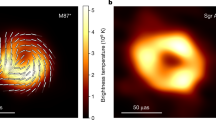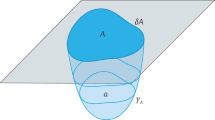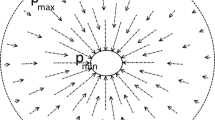Abstract
The conflict between the principles of quantum mechanics and those of general relativity reached crisis proportions with the discovery that black holes have a heat content, or entropy. But efforts to solve the problem have since led to profound and revolutionary new insights into the quantum structure of space–time. In this review, I will explain not only the conflict but also the surprising ideas that can resolve the apparent inconsistencies between the two most fundamental theories of physics.
This is a preview of subscription content, access via your institution
Access options
Subscribe to this journal
Receive 12 print issues and online access
$209.00 per year
only $17.42 per issue
Buy this article
- Purchase on Springer Link
- Instant access to full article PDF
Prices may be subject to local taxes which are calculated during checkout
Similar content being viewed by others
References
Bekenstein, J. D. Generalized second law of thermodynamics in black hole physics. Phys. Rev. D 9, 3292–3300 (1974).
Bekenstein, J. D. Black holes and entropy. Phys. Rev. D 7, 2333–2346 (1973).
Thorne, K. S., Price, R. & Macdonald, D. Black Holes the Membrane Paradigm (Yale Univ. Press, USA, 1986).
Hawking, S. Black hole explosions? Nature 248, 30–31 (1974).
Hawking, S. Particle creation by black holes. Commun. Math. Phys. 43, 199–220 (1975).
Lindesay, J. & Susskind, L. An Introduction to Black Holes, Information and the String Theory Revolution (World Scientific, Singapore, 2004).
Unruh, W. G. Notes on black hole evaporation. Phys. Rev. D 14, 870 (1976).
Page, D. N. Is black hole evaporation predictable? Phys. Rev. Lett. 44, 301 (1980).
Banks, T., Susskind, L. & Peskin, M. E. Difficulties for the evolution of pure states into mixed states. Nucl. Phys. B 244, 125 (1984).
't Hooft, G. in Les Houches Gravitation and Quantizations (eds Julia, B. & Zinn-Austin, J.) 173–179 (Les Houches Summer School Series 57, Elsevier, The Netherlands, 1992).
't Hooft, G. in Proc. New Symmetry Principles in Quantum Field Theory (eds Fröhlich, J. et al.) 275–294 (NATO ASI Series, Plenum, New York, 1992).
't Hooft, G. Quantum information and information loss in general relativity. Preprint at <http://arxiv.org/gr-qc/9509050> (1995).
't Hooft, G. in Proc. Perspectives on High Energy Physics and Cosmology (eds. Gonzalez-Arroyo, A. & Lopez, C.) 1–9 (World Scientific, Singapore, 1992).
't Hooft, G. The scattering matrix approach for the quantum black hole: an overview. Int. J. Mod. Phys. A 11, 4623–4688 (1996).
't Hooft, G. Dimensional reduction in quantum gravity. Preprint at <http://arxiv.org/gr-qc/9310026> (1993).
Hagedorn, R. Nuovo Cimento 3(suppl.), 147–186 (1965).
Fubini, S. & Veneziano, G. Level structure of dual resonance models. Nuovo Cimento A 64, 811–840 (1969).
Bardakci, K. & Mandelstam, S. Analytic solution of the linear-trajectory bootstrap. Phys. Rev. 184, 1640–1644 (1969).
Huang, K. & Weinberg, S. Ultimate temperature and the early universe. Phys. Rev. Lett. 25, 895–897 (1970).
Susskind, L. Some speculations about black hole entropy in string theory. Preprint at <http://arxiv.org/hep-th/9309145> (1993).
Halyo, E., Kol, B., Rajaraman, A. & Susskind, L. Counting Schwarzschild and charged black holes. Phys. Lett. B 401, 15–20 (1997).
Horowitz, G. T. & Polchinski, J. A correspondence principle for black holes and strings. Phys. Rev. D 55, 6189–6197 (1997).
Horowitz, G. T. & Polchinski, J. Self gravitating fundamental strings. Phys. Rev. D 57, 2557–2563 (1998).
Banks, T., Fischler, W., Klebanov, I. R. & Susskind, L. Schwarzschild black holes in matrix theory. II. J. High Energy Phys. 01, 008 (1998).
Danielsson, U. Brane anti-brane systems at finite temperature and the entropy of black branes. J. High Energy Phys. 03, 069 (2004).
Halyo, E. Black hole entropy and superconformal field theories on brane-antibrane systems. J. High Energy Phys. 10, 007 (2004).
Sen, A. Extremal black holes and elementary string states. Mod. Phys. Lett. A 10, 2081–2094 (1995).
Peet, A. W. Entropy and supersymmetry of D-dimensional extremal electric black holes versus string states. Nucl. Phys. B 456, 732–752 (1995).
Breckenridge, J. C., Myers, R. C., Peet, A. W. & Vafa, C. D-branes and spinning black holes. Phys. Lett. B 391, 93–98 (1997).
Polchinski, J. Dirichlet branes and Ramond-Ramond charges. Phys. Rev. Lett. 75, 4724–4727 (1995).
Strominger, A. & Vafa, C. Microscopic origin of the Bekenstein-Hawking entropy. Phys. Lett. B 37, 999–104 (1996).
Dijkgraaf, R., Verlinde, E. & Verlinde, H. BPS Spectrum of the five-brane and black hole entropy. Nucl. Phys. B 486, 77–88 (1997).
Gubser, S. S., Klebanov, I. R. & Peet, A. W. Entropy and temperature of black 3-branes. Phys. Rev. D 54, 3915–3919 (1996).
Horowitz, G. T. & Strominger, A. Counting states of near extremal black holes. Phys. Rev. Lett. 77, 2368–2371 (1996).
Klebanov, I. R. & Tseytlin, A. A. Intersecting M-branes as four-dimensional black holes. Nucl. Phys. B 475, 179–192 (1996).
Klebanov, I. R. & Tseytlin, A. A. Entropy of near-extremal black P-branes. Nucl. Phys. B 475, 164–178 (1996).
Maldacena, J. M. & Susskind, L. D-branes and fat black holes. Nucl. Phys. B 475, 679–690 (1996).
Mathur, S. D. The fuzzball proposal for black holes: an elementary review. Preprint at <http://arxiv.org/hep-th0502050> (1993).
Dabholkar, A. Exact counting of black hole microstates. Preprint at <http://arxiv.org/hep-th/0409148> (2005).
Sen, A. How does a fundamental string stretch its horizon? Preprint at http://arxiv.org/hep-th/0411255 (2004).
Callan, C. G. & Maldacena, J. M. D-brane approach to black hole quantum mechanics. Nucl. Phys. B 472, 591–608 (1996).
Das, S. R. & Mathur, S. D. Comparing decay rates for black holes and D-branes. Nucl. Phys. B 478, 561–576 (1996).
Das, S. R., Gibbons, G. W. & Mathur, S. D. Universality of low-energy absorption cross-sections for black holes. Phys. Rev. Lett. 78, 417–419 (1997).
Das, S. R. & Mathur, S. D. Interactions involving D-branes. Nucl. Phys. B 482, 153–172 (1996).
Dhar, A., Mandal, G., Spenta, R. & Wadia, S. R. Absorption versus decay of black holes in string theory and T-symmetry. Phys. Lett. B 388, 51–59 (1996).
Susskind, L. & Thorlacius, L. Gedanken experiments involving black holes. Phys. Rev. D 49, 966–974 (1994).
Susskind, L. The world as a hologram. J. Math. Phys. 36, 6377–6396 (1995).
Maldacena, J. M. The large N limit of superconformal field theories and supergravity. Adv. Theor. Math. Phys. 2, 231–252 (1998).
Witten, E. Anti-de Sitter space and holography. Preprint at <http://arxiv.org/hep-th/9802150> (1998).
Susskind, L. & Witten, E. The holographic bound in anti-de Sitter space. Preprint at <http://arxiv.org/hep-th/9805114> (1998).
Banados, M., Henneaux, M., Teitelboim, C. & Zanelli, J. Geometry of the (2+1) black hole. Phys. Rev. D 48, 1506–1525 (1993).
Banados, M., Teitelboim, C. & Zanelli, J. The black hole in three-dimensional space-time. Phys. Rev. Lett. 69, 1849–1851 (1992).
Witten, E. Anti-de Sitter space, thermal phase transition, and confinement in gauge theories. Adv. Theor. Math. Phys. 2, 505–532 (1998).
Maldacena, J. M. Eternal black holes in AdS. J. High Energy Phys. 04, 021 (2003).
Susskind, L. String theory and the principle of black hole complementarity. Phys. Rev. Lett. 71, 2367–2368 (1993).
Susskind, L., Thorlacius, L. & Uglum, J. The stretched horizon and black hole complementarity. Phys. Rev. D 48, 3743–3761 (1993).
Hawking, S. Breakdown of predictability in gravitational collapse. Phys. Rev. D 14, 2460–2473 (1976).
Acknowledgements
L.S. is supported by the National Science Foundation under PHY-0097915.
Author information
Authors and Affiliations
Rights and permissions
About this article
Cite this article
Susskind, L. The paradox of quantum black holes. Nature Phys 2, 665–677 (2006). https://doi.org/10.1038/nphys429
Issue Date:
DOI: https://doi.org/10.1038/nphys429
This article is cited by
-
Lost horizon? – modeling black holes in string theory
European Journal for Philosophy of Science (2021)
-
Quantum simulation of Unruh radiation
Nature Physics (2019)
-
Observation of quantum Hawking radiation and its entanglement in an analogue black hole
Nature Physics (2016)
-
GUP Corrected Fermion Tunnelling from 2 + 1 Dimensional Black String
International Journal of Theoretical Physics (2016)
-
Deformed Hamilton-Jacobi Equations and the Tunneling Radiation of the Higher-Dimensional RN-(A)dS Black Hole
International Journal of Theoretical Physics (2016)



